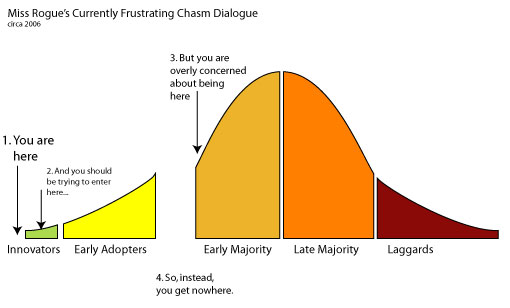Editors Note: This is a guest post by first-time entrepreneur Mike Potter (LinkedIn, @mike_j_potter) who previously was a Marketing Manager at Adobe, a project manager at Mozilla and an engineer at an Ottawa area startup. Mike has spent time running marketing programs for a large organization and has realized that power he held for many early-stage startups.
It has been 5 months since I left my job at Adobe and started my own company, Arkli. We are building software to help create and measure integrated marketing campaigns. If I’d known how little it takes to help a startup, I would have tried to do far more when I was Adobe. It has been the experience of starting my own business, and demonstrating customer traction to potential investors and potential customers that I’ve come to realize how important 1 or 2 early customers like Adobe can be for a startup.
Traction is the new black

![]()
![]()
![]() Some rights reserved by Jinx1303
Some rights reserved by Jinx1303
Demonstrating customer traction even in small numbers (particularly for enterprise or B2B startups) is the thing that helps you get the next meeting, the next introduction or the conversation that can really help your startup. For example, we’ve been in business for less than 7 months and we have 2 customers. When I was at Adobe, I would have said only 2 customers – that’s all you have? We had tens of thousands of customers. It was unclear that 2 customers could matter on the scale and scope of Adobe. Now running a startup, I look at it and say “wow, 2 customers, that’s great!” Investors say the same thing. Someone recently commented, “I’m impressed you’ve gotten customers without outside investment.” And it’s not just me, a panelist on BNN’s The Pitch congratulate Dalia Asterbadi (LinkedIn, @d_asterra) of realSociable on her partners and her user numbers. The best part is RealSociable hasn’t launched yet!
The reality is that getting customers to pay for something is really hard. Which is why when you’re starting out, everyone says going to take twice as long and cost twice as much as what you think. And it does, because its really hard to get early adopters. Silicon Valley is full of early adopters who help give traction startups. We need more of them in Canada.
Getting to the chasm

![]() Some rights reserved by Original Nomad
Some rights reserved by Original Nomad
I really believe that the best thing a community can do to help local economy is to support local businesses and startups. We can argue about how much companies like RIM matter to startups. But it doesn’t have to be all mergers, acquisitions and corporate venture capital funds. It is not about new headcount or stock price. It’s about curiosity to seek out new solutions to your existing business problems.
If you’re reading this, you’re probably interested in startups. Are you a founder? Do you work for a startup? Are you working for a larger organization? Here’s how you can help:
Taking selfish advantage of an economic situation
Look at your everyday problems. Are you struggling with accounting software, check out WaveAccounting. Everybody hates HR, have you checked out TribeHR? Can’t get your kids to do their chores, maybe HighScoreHouse can help make chores a game. Did you experience downtime because EC2 was offline for 5 days, maybe VMFarms can support you local and on EC2. There are a ton of startups with solutions to consumer and enterprise problems. It can be a struggle as a startup to raise your awareness event with early adopters. [Editor’s Note: There were 42 submissions and 5 accepted demos at the most recent DemoCamp. You can tune into the startup news sources like StartupNorth, NextMontreal, TechVibes and others. It can be a challenge but we’re working on better ways to discover Canadian startups. You can find early access to our redesigned StartupNorth Index of companies. It is currently running on our staging server, but the data model is solid an we’ll move all entered data to the production instance in the coming weeks.]
We need to build and embrace a culture of early adopters. Look at your business operations, where are things not working as smoothly as you’d like. This is where you might be able to find a startup that you can take a flier on to help you improve the broken process. This is a chance to help an early stage startup.
Become an early adopter of a startups product. Use it for 6 months and give it a shot. When you’re working for a fairly large company (employs more than 10 or so), you’ve got nothing to lose. [Editor’s note: Nothing to lose, other than your job ;-)]. Hopefully you will have found a product that makes you day-to-day responsibilities easier, smarter, faster, more enjoyable. You get to go home at the end of the day with a pay cheque, and hopefully fixed a broken part of your job with very little risk or cost.
And you might have helped seed a startup. It takes so very little to help a startup demonstrate traction. A few customers which can lead to new investors which can lead into job creation in the community. It’s a cycle of early adoption in that we desperately need to start in Canada.
Embrace your role as an early adopter
Nobody ever gets fired for buying IBM. This might be true. But you’ll be giving a lifeline and valuable feedback to an entrepreneur by choosing their products. One of the great thing about being a startup is that many of us are innovators and early adopters. Our mail has been in the cloud since 2005, when we embraced GMail (for the massive storage). The iPhone seemed like the best way to stop carrying an iPod and a Blackberry in 2007. We constantly seek out new and improved technology products. We need to embrace the same eagerness to try personal technologies in our organizations. Whether it’s new technology like Node.js or Cassandra, or a new way to track real-time team performance (looking at your Rypple).
For startups traction is the new black. And it’s up us as middle managers and executives to seek out novel solutions. And in becoming a customer you might have just helped the next Facebook/Google/Oracle/Microsoft/Apple/etc.
What new products are you using that are reshaping your business?
Editors Note: This is a guest post by first-time entrepreneur Mike Potter (LinkedIn, @mike_j_potter) who previously was a Marketing Manager at Adobe, a project manager at Mozilla and an engineer at an Ottawa area startup. Mike has spent time running marketing programs for a large organization and has realized that power he held for many early-stage startups.

